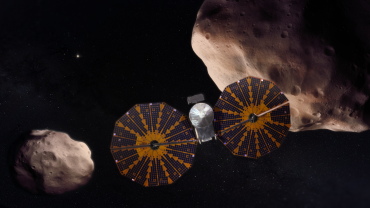
Artist’s impression of Lucy passing by a binary Trojan asteroid. Image credit: NASA’s Goddard Space Flight Center/Conceptual Image Lab/Adriana Gutierrez
Back in 2015 the New Horizons spacecraft whizzed past Pluto on its way out of the Solar System. A few years later, as it continued on its way through the Kuiper Belt, it passed by a snowman-shaped object called Arrokoth. More recently, it’s discovered two objects that are in fact four – binary objects comprised of two smaller objects orbiting each other.
As Dr James Robinson, from the University of Edinburgh explains, the discovery of these objects is very useful for understanding the Kuiper Belt, and the different groups of objects within. In turn, that is important for understanding the formation of our Solar System.
Closer in, the Lucy spacecraft has recently launched on its way out to the Trojan asteroids, location near Jupiter. The first mission to these unusual objects, Lucy will shed light on a type of object we’ve never seen before.





